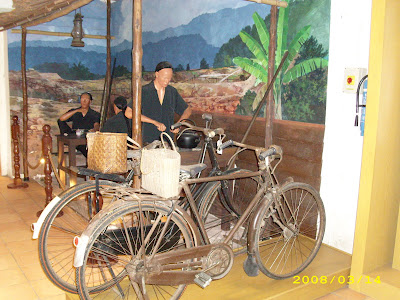Built by the British in 1929, the Taiping Aerodrome as the Brits would have preferred to called it, was one of the first airfield built in Peninsular Malaysia, the other being in Alor Setar at around the same time.
Due to the short runway of about 1.3 km with a mix surface of tarmac and grass, it was only suitable for small planes like the Fokkers.
Through the years, I recall from memory, it was used as a military airfield in the 70 to 8o's. I remember watching the air force's Caribous twin props landing in it a couple of times in the afternoon while fishing in the disused tin mine ponds located next to it as a young boy.
The Airport "check-in and departure terminal" .
There was also a point in time where the Taiping Aerodrome made air transport history, as it was at this airfield Sukarno and Mohd Hatta, the first president and former vice-president of Indonesia landed in 1945 after the surrender of the Japanese forces, to discuss independence for Malaya and Indonesia with Dr.Burhanuddin and Ibrahim Yaacob, leaders of the Union of Peninsular Indonesians for joint independence for both nations. The Brits found it unagreeable and Indonesia went on to gain independence not long after, with Malaya still under the Brits.
The tallest structure in the aerodrome is what used to be, the "Control Tower".

The status of the aerodrome currently, I believe is no longer functioning and is sadly in a state of neglect, abandoned would be a better word to describe it, with only very minimal upkeep done, the grass on the runway is still being mowed and that is about it. The fence forming the parameter of the airfield is partially broken. There is a make shift soccer field built by the locals at the far end of the runway and I saw, I think, Tae Kwon Do classes being conducted in one of the empty sheds of what is left of an administration office.
The eco friendly "grass runway".


An on going soccer game on the "runway" and the "Tarmac" part of the runway.


The Taiping Aerodrome although being one of the first airfield to be built in the country would unfortunately, due to its close proximity to Penang International Airport and Ipoh Airport both
being more strategically located, would never see itself being develop further and at best will most likely serve out its purpose as a possible emergency airfield for light aircraft.










 Amongst Hartwell's more well known other works are:-
Amongst Hartwell's more well known other works are:-
 Fort Ngah Ibrahim located in Matang near Taiping, is a place worthy of a visit if you are in town. It has recently completed renovation and the exhibits given a new lease of life, being off the normal tourist trail it's existence is not known to many.
Fort Ngah Ibrahim located in Matang near Taiping, is a place worthy of a visit if you are in town. It has recently completed renovation and the exhibits given a new lease of life, being off the normal tourist trail it's existence is not known to many.








 Inside the fort .....
Inside the fort ..... 



 Ngah Ibrahim's room -
Ngah Ibrahim's room -




 The actual room used for detention in the fort -
The actual room used for detention in the fort - 

 The fort during the Japanese occupation -
The fort during the Japanese occupation - 



 British Instruments used during the era -
British Instruments used during the era - 


 The man himself -
The man himself -  In the year 2007, Ngah Ibrahim's remains was finally returned from it's long exile in Singapore and laid to rest in his very own fort.
In the year 2007, Ngah Ibrahim's remains was finally returned from it's long exile in Singapore and laid to rest in his very own fort.